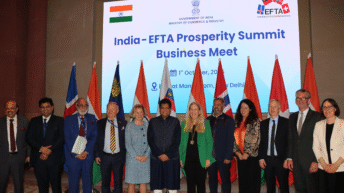
In an era when narratives have unprecedented influence and where the battle of cultural ideologies rages, India stands at a pivotal juncture. India, known for its kaleidoscope of rich cultural and historical heritage, has now become the battleground of the phenomenon known as ‘wokeism’. Though ostensibly rooted in a noble effort to right injustices, the term has evolved into a powerful cultural force, akin to a double-edged sword poised to divide rather than unite. When we delve into the implications of the woke-narratives in the Indian context, it is unmistakably clear that India needs to create a forward-looking agenda – one that protects its cultural identity while also involving fundamental transformations.
The genesis of the term “wokeism” can be traced back to its origins as an indicator of heightened awareness of social and racial injustices, predominantly in European and Western societies. Undoubtedly, there are individuals who identify as “woke” with a genuine commitment to addressing these issues and catalyzing constructive change. However, the culture that has grown up around the term paints a starkly contrasting picture. It presents itself as a revolution, a rebellion against established norms, but paradoxically it often thrives in the very systems it claims to challenge. This glaring contradiction beckons us to examine the authentic motivations behind woke-culture.
The cultural battlefield is not unique to India; it is a worldwide phenomenon. However, it manifests itself differently in each context and is shaped by specific historical, cultural and socio-political factors of the region. In India, as in many other countries, woke-narratives intersect with issues that range from cultural traditions, socio-economic developments to environmental concerns. These narratives become particularly visible during certain times of the year, such as during Diwali, when debates over the use of firecrackers flare up. Consider, for example, the involvement of organizations like PETA at certain festivals. While the intentions behind animal welfare advocacy are noble, this approach can be divisive. Such campaigns create a binary narrative where one must either be “woke” and against traditional practices, or be labeled as regressive and insensitive. This polarised approach contributes to a growing “my way or the highway” culture that threatens to undermine the fabric of Indian society.
India’s response to wokeism parallels the experience of many countries in the West where issues have been hijacked and reframed to suit a particular agenda. In the Indian context, this often involves importing Western ideas and applying them to situations that are vastly different. While there may be some common concerns, it is essential to recognise the nuances and unique cultural contexts of each country.
The emergence of wokeism as a prominent challenge of the modern age calls for a closer examination of its impact on Indian society. It is not only about the adoption of Western ideas, but also how these ideas are used for other agendas that are not necessarily in line with the best interests of the country. There is a danger that if we are not vigilant, these woke-narratives could gradually erode the foundations of our cultural identity.
What’s particularly troubling is how market forces have aligned with this woke-culture. It is as if these woke-narratives have been commodified, turned into a tradable product. Those who are most vocal in promoting these narratives are often those who gain the most financially and socially. But the deeper problem lies in the fact that these woke-narratives often try to monopolize the narrative space. They don’t just want to highlight the problems or injustices; they want to be the sole authors of the stories society consumes. Their goal is to dominate the narrative to such an extent that individuals are left with no choice but to accept their worldview. This phenomenon is not limited to India; it is a global problem. It is about manipulating narratives, weaponising words and insidiously spreading ideological hegemony. It’s about how, in a digitally connected world, dominant narratives can shape public opinion, even if those narratives may not be entirely accurate or fair.
So how does India navigate this complex landscape where woke-culture is on the rise, cultural traditions are under scrutiny and a vocal minority seeks to dictate the terms of discourse?
First, we must recognize that India has a great history of resilience and adaptability. Throughout its long and varied history, it has weathered countless storms, embraced change and maintained its cultural identity. This is not a call to resist all change, but rather to ensure that change is based on an understanding of the local context and respects the country’s rich cultural heritage.
Education is a powerful tool in this regard. The youth of this nation need to be educated about the dynamics of woke-narratives and the potential pitfalls of unquestioningly following them. It is essential to teach critical thinking skills so that the younger generation can distinguish between genuine efforts for social justice and manipulation of these issues for personal or political gain.
While freedom of expression is a fundamental right, it is also necessary to strike a balance that prevents the misuse of media and digital platforms to spread divisive narratives. Regulation of OTT (Over-The-Top) content and stand-up comedians, for example, can help limit the spread of harmful ideologies and narratives. Such regulations should be drafted with a sense of freedom of expression, but also with a keen awareness of potential harm.
Additionally, it is important to note that there is often an organised effort behind the spread of such narratives in India. These woke-narratives are not always grassroots movements; more often they are strategically promoted by organised institutions and external forces. Identifying and addressing these sources of influence is critical to understanding and mitigating the impact of wokeism in the country.
On an individual level, each person must take responsibility for their role in perpetuating or challenging these woke-narratives. It’s easy to get stuck in the echo chambers of social media, where dissenting voices are drowned out and conformity is rewarded with likes and retweets. However, one must resist the temptation to blindly follow these narratives and instead seek out different perspectives and engage in constructive dialogue.
India stands at a critical juncture where the clash between woke-narratives and cultural traditions is becoming more pronounced. While it is essential to address social injustices and advocate for positive change, it is equally important to do so in a way that respects the nation’s cultural diversity and historical richness. India has a long history of adapting and evolving while maintaining its cultural identity and must continue to do so in the face of the challenges posed by wokeism.
India must create and set its own self-sustaining narrative involving education, regulation, awareness and a collective commitment to preserve the values that have held the nation together for centuries. It is a delicate balancing act, but one that is necessary to ensure that India’s cultural heritage remains alive and intact for years to come. In this endeavour, it is imperative that India does not fall victim to the divisive and monopolistic tendencies of the woke-narratives, but instead charts a path that promotes unity, inclusiveness and progress while celebrating its rich cultural identity!






Add comment